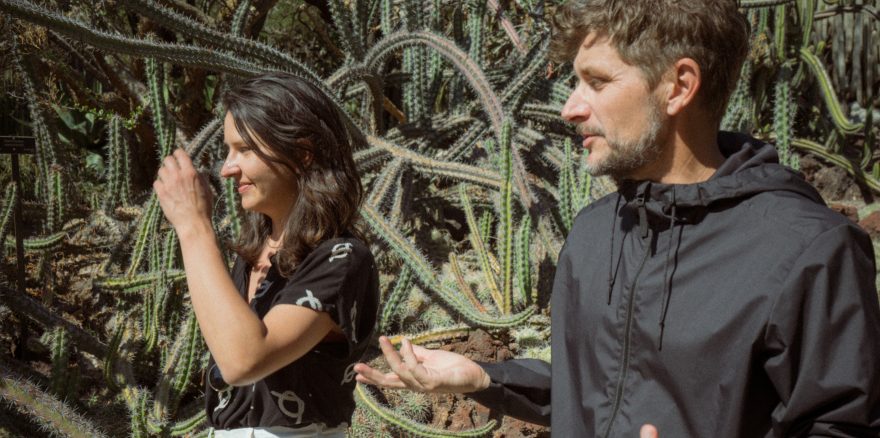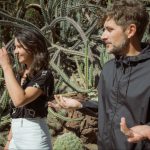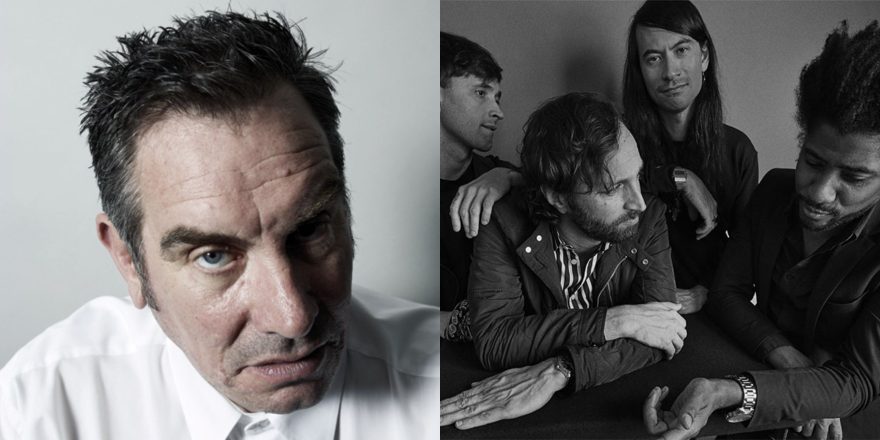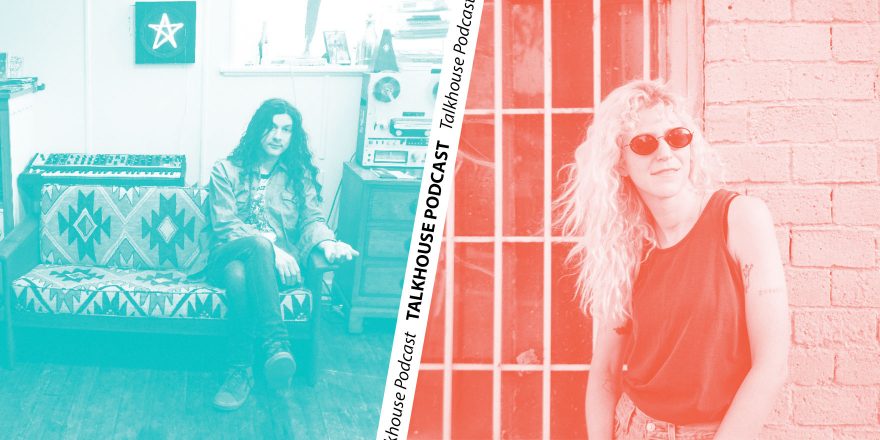Stella Mozgawa is the drummer of Warpaint; Bryan Hollon is a producer and musician who performs as Boom Bip and as one-half of Neon Neon. The two recently came together to form Belief, an experimental dance music duo, and just released their debut self-titled album on Lex last month. To celebrate, the two reminisced about the 13 year friendship that led up to its creation.
— Annie Fell, Editor-in-chief, Talkhouse Music
Stella Mozgawa: Let’s look at the questions.
Bryan Hollon: “How did you two first meet?” I remember that very well. I was in the Warpaint rehearsal space, and I was playing drums. You came up the stairs and came into the room while I was playing, and I was like, “Oh, hi. Who are you?” And you’re like, “I’m Stella. I’m the new drummer for Warpaint.” And you said, “I really like your drum style. You kind of have a Bonham sound going on,” or something like that, which is really funny because I think I’m the lightest drummer. It sounds like I play with chopsticks.
Stella: Amazing. I said “Bonham”?
Bryan: Yeah. I’m sure it was just that room, because it was just a big echoey wooden room.
Stella: Yeah. That was above the Echoplex, in LA. I definitely remember seeing you a couple of times, and I remember seeing you that first time because I was also thinking the same thing, like, Who is this person? Who is this guy in the studio?
Bryan: Yeah, because it was Josh Klinghoffer [former RHCP guitarist] and I had one end of the studio that we were sharing, and Warpaint had the other half.
Stella: It’s all conflated into one single memory, but I know it was probably multiple months, but I feel like the day I met you was also the first day I played with the band. So we’ve known each other — I mean, I wouldn’t say we were friends straight away, but we met 13 years ago now. Isn’t that nuts?
Bryan: Wow, that is nuts.
Stella: It felt like a really brief moment where we met, and then we just kind of kept seeing each other.
Bryan: Around that time, I was likely working on the second Neon Neon album with Gruff Rhys, I think our worlds were just kind of mixing — it was kind of an incestuous circle of musicians around that time. Cate LeBon was kind of part of that too, because she was part of the Neon Neon thing originally.
Stella: Yes, yes.
Bryan: I remember we needed to do some West Coast dates, and you and I seemed pretty close at that time because I remember asking you to play on that tour seemed like the most natural, easiest, most fun situation.
Stella: Yeah, we were not strangers at that point.
Bryan: No, it felt really comfortable. And so we did that run of dates together.
Stella: Which was so fun. It was you and Gruff and Cate LeBon on guitar and backing vocals, and Huw Evans on bass — a normal bass and also a fretless bass, I remember. [Laughs.]
Bryan: I miss that fretless bass. I bought that fretless bass in the UK as a half joke, but I also really was just like, God, I just love the sound of the fretless bass.
Stella: That was amazing. I remember it was still kind of funny, and now it feels like fretless bass isn’t funny anymore. It’s all come back around.
Bryan: It’s very desirable, yeah.
Stella: I always felt like Neon Neon was a few years ahead of its time with its references, you know. It’s like reflexive, kind of referential music, and stylistically always felt a little bit ahead of the curve, and that fretless bass was an indicator of that.
Bryan: [Laughs.] That tour was so much fun. That would have been a great band to do the entire tour.
Stella: I know. But I kind of also feel like short tours with your friends are always the most memorable, because you never really get to that that emotional, psychological breaking point.
Bryan: True.
Stella: You never get fatigued. It’s just so exciting. Short tours are usually just the major cities where people are coming out and the shows are sold out. I just feel like it’s the best case scenario. And we were all kind of getting to know each other then, even though we all knew each other from different worlds. That was that felt to me like a really powerful moment of friendship for all of us.
I guess I was thinking about this today just because our album comes out in two days, which blows my mind. I was just trying to think of how many situations I’ve been in that have been similar, where a friend and I are talking about making a record together and we kind of have a concept and we get excited planning it and can start imagining what it will sound like and what it will feel like to to make that music with that person that you love — but it just so rarely happens, you know?
Bryan: Yeah, it’s true. I mean, a lot of times it’s talked about, but to see it through is a rare accomplishment. And with us, it wasn’t easy, but I think part of the appeal was that we didn’t put any pressure on each other, we didn’t have pressure from the record label. We never had a stressful moment with it. We allowed ourselves to enjoy the process and waited until we could be in the same room together. Because we really wanted to be in the same room to record it rather than doing a, you know, “I’m going to mail this to you and work on it.” And in the end, with the pandemic, obviously, we had to do a little bit of that. But for the most part, we were in the same room together throughout the entire process.
Stella: I reckon, like, 80-85% of the record was done in the same room. Thank god. I I think it would have been a different sounding record otherwise. I’ve just realized over the course of the last two or three years that, as much as I want to be flexible and I want to make music any which way — you know, like on tour on the bus, in the hotel rooms, if I’m in another country, if I’m on holiday — it’s never as good or as fun or as quick as it is when you’re just in a room with someone you know. Some people are really good at that, because they go into their own worlds and they have their own systems and musical processes. But I just don’t have that at all. I’m always feeding off other people. And I feel like you and I really enjoyed that collaboration, instead of it just being like a, it looks good on paper kind of collaboration. We enjoyed actually physically being in the same room and making decisions like that.
Bryan: Yeah. I’ve had a tendency, just from experience in the past of overworking songs or a record, having too much time and just doing too much to it. Especially with this stuff — because really what we were inspired by was that kind of early ‘90s acid house scene, which a lot of times that was one or two people with a bunch of machines hooked into each other playing live, because there really wasn’t a good way to track things in that era separately.
Stella: That’s so true. I never even thought about that.
Bryan: Yeah. So, I mean, you really were going into a Mackie mixer, and then you have a stereo out that you’re tracking on a DAT tape. That’s how the majority of those records were made, and they sound amazing because they are punchy and unedited and it’s not overly compressed, and it’s all over the place.
So for you and I, I know that’s where we got most of our fulfillment with this record. When we started in Eric Wareheim’s film studio, Abso Lutely — the Tim & Eric film studio, which was really the only available space at the time — we recorded the hours of jamming. I think that’s really when you and I discussed that we both really appreciated and loved that ‘90s house and and early electronic stuff. So we were like, let’s just try to make that. Like, we’ve got enough stuff.
Stella: [Laughs.] We’ve got a lot of gear.
Bryan: Let’s hook it all up and just start jamming and see if this is going to work or not. I remember those first couple of days when we did that was really magical. You and I were deep into jamming, and the transitions and the changes and the dropouts and stuff that were all happening naturally was this unspoken process. We didn’t really need to say, “OK, on the count of three, let’s drop out.” You and I were just communicating naturally, and right away I knew, Oh, my god, we gotta make a record, because we’re not even talking and this sounds great.
Stella: Yeah.Hearing you talk about that, the jamming element — I mean, god forbid, that word, it’s so gross. But we did a lot of that. It is a huge realization that I had about what a musician like myself can bring to, maybe, a genre that’s just been done so well for so long. You often think, what can you actually bring to the table? And I don’t think we’re reinventing the wheel, but we both do come from a kind of live-centric [background]. You know, you with electronic music and myself with bands, it’s a similar kind of philosophy of improvising in the moment and feeding off somebody else’s energy. Looking back now at bands or artists like LFO, Aphex Twin, you know, bands that we love from that early Warp era — it was that same process, even if they were working independently or with just two people in a room. There is that element which you don’t necessarily associate with electronic music.
Now, when people think electronic music, they think of someone sitting on a MacBook automating on Ableton, and going through and kind of laboring over each section. Which is a craft in itself, of course, but it’s a different part of the brain than playing music in a room with someone. The revelation that I had was, Oh, my god, I can actually bring some of these skills that I have from improvising with people, playing an instrument with somebody in a room. It’s the same as playing on a drum machine and you on a synth, or vice versa, and responding to what the other person is doing and trying to find a way to build some kind of structure. And I just love that aspect of it. I think some of the funnest musical experiences I’ve had is just you and I jamming, either rehearsing for a show that we’re playing where we’re doing a live set or composing something for the record.
Bryan: Yeah, me too.
Stella: Those are the most joyous memories I have of making the record, for sure. You’re using whatever you have without a lot of discussion and without a lot of structure, and just hoping for the best, you know? And that’s really thrilling to be able to do that with instruments that you’re not necessarily completely accustomed to.
Bryan: Yeah. It’s very much like jazz in a way. I mean, you’re using machines, so in some ways it’s the complete opposite. But it’s the idea of just, it takes time to get into a groove and to build up to it and build out of it. I think jazz and the kind of the early Acid house stuff, there’s kind of a seven minute range. There’s a format — it takes seven minutes to get up and then back down to a place where you’re like, OK, it’s time to end here. Where a rock song is three minutes, or a pop song’s two and a half minutes and then you’re exhausted. But this music, seven minutes seems to be that—
Stella: It’s enough.
Bryan: Yeah.
Stella: That’s a really good point. I never really made that connection. I guess I was thinking more about the live improv world. Which it the jazz world as well, very much.
Bryan: Yeah. We should state that a lot of the tracks, I think the majority of them, were built from, for lack of a better term, these jams — these live improvisations where we had at least two or three elements that we were playing live, and then we would go back and add a few layers to it. But a lot of those were nine to 14 minutes, and you’d have to find the best bit and edit it to make it feel like a cohesive piece of music that’s four or five minutes long. Otherwise, you have a 95 minute record, which nobody needs in their life.
Stella: Yeah, I think that was what kept us going, that initial excitement of those… performances. I’m trying to substitute the word “jam.” [Laughs.] I think that’s what sustained us through the editing process. I remember you and I joking, when we were in the weeds of editing the performances that we did, and trying to get them into some kind of cohesive framework — at that point we had just been staring at a screen for a few hours, and I remember you saying, “I don’t even feel like a musician anymore, I just feel like an editor.” You have to have that long game and that vision and that initial excitement still present to be able to go through the annoying — I find it to be. I mean, it can be very creative as well, but I find it a lot more laborious than making something from scratch. I think we were both excited enough about what we had produced organically that we could get through the more annoying parts of editing really long jams.
Bryan: Well, part of a solution to that — because I remember you were getting busy doing some other work, and I was going back and trying to pick the best bits and maybe find better tones, or a hi-hat or something, little things that we needed. And I came to the realization: I don’t want to sit here and just search through all of these sounds. Because, first of all, I wanted you to be part of the process. Secondly, you’re an incredible drummer — one of the best drummers on the planet. And I was like, We haven’t showcased any of Stella’s drumming on this. I remember thinking, you’ve done some really great drum programming with the drum machines, but let’s try to get more of you on here playing live. And so that helped me put off that tedious editing process of going and finding things. And I’m so glad that we did that, because there are tracks like “Dreams,” where the second half of the track, you come in playing live hi-hat and snare and some percussion, and that combined with the drum machines just gives it this incredible feel.
Stella: Yeah, it’s actually almost like a shortcut.
Bryan: It is a shortcut.
Stella: Because try as I might to get to the same efficiency with programming as I have with just playing drums — all the little micro decisions when you’re performing, and the way that a snare is going to sound different on every single kit — trying to program that kind of feel is Aphex Twin-level programming, I think, which I’ll never achieve that. So the shortcut for me is just to actually play it and then get that idea down. It makes it easier for everyone, you know?
Bryan: Well, it does when you have a drummer at your caliber. Because, just so you know, I would try to do the stuff on my own, and I would go back and look at the grid and it was a nightmare. [Laughs.] And then you would do it, and you were like a metronome. I was just shocked. There was no editing to be done. You just locked in. Your timing is just incredible, and so it made my job so much easier. And it was fun how we recorded some breaks out at Rancho de la Luna that I was able to sample on some of the tracks. We could isolate a few drums and grab longer 16 bar loops.
Stella: Yeah. I think the main thing that I’ve discovered about making electronic music is that you have to sustain a different kind of interest than with a conventional pop song or rock song. Because it’s all in the nuance of every instrument. Again, another shortcut is just being able to input those nuances, just from somebody playing something that’s not completely looped. As comforting as a loop is, it is also really recognizable. You know when something isn’t played live. We ended up putting quite a lot of that on the record— I’m really glad that you pushed for that, because in my mind, I was like, No, I’ve been playing drums for so long. I wanted to do something that was completely different. But I think we managed to marry those two worlds.
Bryan: Yeah, and we didn’t do too much. I just know there are going to be a lot of Stella fans out there that will want to hear a little bit of that. And also, you and I love breaks. We love sampled bass. And so it just was strange for us to be searching through breaks when we’ve got a drum kit sitting behind us and and you’re in the room.
Stella: Yeah, totally. To be honest, I don’t know if I’ve found an amazing programmed hi-hat or ride. I mean, the ride sound on the 909 is amazing, or the 707. But I’m never fully satisfied with what I hear in sample libraries. When I start programming itm I have to do all these micro adjustments so that has the same feel.
Bryan: Yeah, same.
Stella: And now I love a lot of the new drum machines, like the TR-8S, which we’ve been using live a lot, and we used quite a bit on the record. I think a lot of those newer drum machines have the automated feel — they call it motion recording or whatever, and you can record in that kind of natural movement of something like a hi-hat. Which is so important because it just feels so annoyingly metronomic otherwise.
Bryan: Yeah. Or they offer a shuffle or something, that you can knock it off just a bit that gives it that perfect swing.
Stella: A little more of a human feel.
Bryan: Well, anything else we should talk about?
Stella: Let me look at the other questions. “Where did you draw inspiration from? What are some of your favorite dance records?” I think we talked we talked about LFO. I think because Mark Bell’s output was quite varied, the career that he had was really inspiring to me. The range that he had was inspiring. You and I connected on that a lot, and I know that you had actually spent time with him back in the day. He’s a musical figure that just kept coming up for us.
Bryan: Yeah, Mark was huge for me. What I find with with Mark’s music is — and this is probably why he ended up working with Bjork — is that he’s a master at making these electronic instruments sound organic and have that human feel to them. So when you listen to an LFO record, even though you’re listening to all of these sounds you’ve never heard before that only machines can do there’s a really human element there. If you listen to our record, it might not sound like an LFO record, but I think the thing that we were successful in doing was kind of humanizing those instruments, and I think our record has that same feel that an LFO record has.
Stella: The same intention of trying to, trying to make live music, or live breaks, more robotic and making electronic music a little more organic or something.
Bryan: And there’s a lot of heart in it. Mark is one of the sweetest people, and I think I hear a lot of heart in his music, too. Because it’s very easy to make cold, heartless music.
Stella: Which can be can be very beautiful as well. It can be very attractive.
Bryan: Yeah, I love that stuff too. And he was successful at doing that as well. But we almost can’t help it, I think just coming from our backgrounds and who we are as people. Yeah. That, you know, tracks on our record, like “Jung” and “Ulu,” there’s a lot of mood and that’s a very human element to the to what’s happening there.
Stella: Yep. Emotional electronic music.
Bryan: It’s a fun challenge, musically, to try to accomplish that. Because it’s really easy to have everything quantized and syncopated and cold, you know? So I think you and I really focused on adding warmth to something that felt too cold, to give it that that feel. I’m trying to think who else was a big who else was a big inspiration.
Stella: There’s this Japanese artist that I just got into recently, who I didn’t know had also passed away, maybe 10 years ago, Susumu Yokota.
Bryan: Oh, absolutely.
Stella: The Sakura record and the Acid Mt. Fuji record. I started listening to that, actually, probably towards the end of us making the record, and I think I may be sent it to you and you wrote back and said, “This Acid Mt. Fuji is literally my favorite record of the last 20 or so years.” I listened back to a lot of the music that we’ve been sharing and the music we’d be making together, and it made a lot of sense to me.
Bryan: I think 808 State was a big one for us too.
Stella: Yes, 100%. I remember I got really into Madonna’s “Frozen” for about three months. We kind of did a mad dash of seeing each other almost every night for a few weeks while we were trying to really finish the record, and I just couldn’t stop listening to that song for some reason. I remember coming into your studio and making you play the song, and then you playing me some of your favorite Madonna songs. I don’t know how that influenced the record, but I remember it made a big impression on me.
Bryan: Me too. The Erotica record was huge for me, and there’s tons of 909. I mean, the producers that she worked with all in that early ‘90s era, she was really on that house sound.
Stella: What else can we talk about?
Bryan: I think that’s about it. I’m just excited to release the record finally, after all of this time. It’s bizarre that it’s finally coming out. I feel happy, and actually a little sad at the same time, because the build up was long and fun and now it’s here. I’m really excited to share it with people.
Stella: I’m excited to keep making music with you.
Bryan: Yes, me too. Can’t wait.
(Photo Credit: Ali Lee Hollon)






